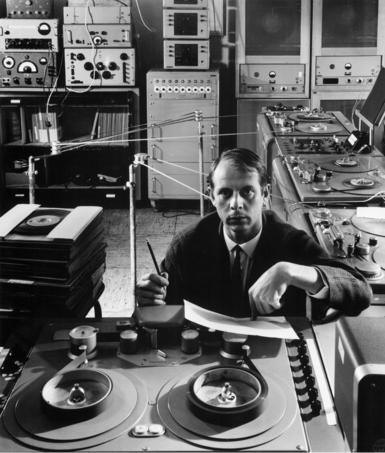Omaggio a Stockhausen
Fondazione Calderara - Vacciago di Ameno - h 12.00
Maurizio Barbetti viola
Francesco Cuoghi, chitarra ed elettronica
introduzione
Riccardo Sinigaglia
Karlheinz Stockhausen
Gesang der Jünglinge per nastro (1955-56)Eckart Beinke
Prelude (viola)David Macculi
RagàBarbara Magnoni
RegheshKarlheinz Stockhausen
Spiral (1968) for a soloist with short-wave receiver
versione per ricevitore a onde corte, chitarra ed elettronicaBruno Strobl
“…brennt so, dass man es sieht…” (2004) per viola e chit.Luciano Berio
Abbagnata e Ninna Nanna - viola sola e vla e chit.
Gesang der Jünglinge
From Wikipedia, the free encyclopedia
Gesang der Jünglinge (literally "Song of the Youths") is a noted Electronic Music work by Karlheinz Stockhausen. It was realized 1955-56 at the Westdeutscher Rundfunk studio in Cologne.
The work, routinely described as "the first masterpiece of electronic music" (Simms 1986, 391; Kohl 1998, 61) and "an opus, in the most emphatic sense of the term" (Decroupet and Ungeheuer 1998, 97), is significant in that it seamlessly integrates electronic sounds with the human voice by means of matching voice resonances with pitch, and creating sounds of phonemes electronically. In this way, for the first time ever it successfully brought together the two opposing worlds of the purely electronically generated German Elektronische Musik, and the French Musique Concrète, which transforms recordings of acoustical events. Gesang der Jünglinge is also noted for its early use of spatiality; it was originally in five-channel sound, which was later reduced to just four channels (mixed to monaural and later to stereo for commercial recording release). When composing Gesang der Jünglinge, Stockhausen attempted to expand on the earlier work of Anton Webern, and composed the piece as a work of Total serialism, serializing the pitch, duration, dynamics, and timbre of every electronic and vocal event.
There are three basic types of material used: (1) the recorded voice of a boy soprano, (2) electronically generated sine tones, (3) electronically generated pulses (clicks). Each of these may be composed along a scale running from discrete events to massed "complexes" structured statistically (Decroupet and Ungeheuer 1998). The last category occurs in Stockhausen's electronic music for the first time in Gesang der Jünglinge, and originates in the course of studies Stockhausen took between 1954 and 1956 with Werner Meyer-Eppler at the University of Bonn.
The text of Gesang der Jünglinge is from a Biblical story in The Book of Daniel where Nebuchadnezzar throws Shadrach, Meshach, and Abednego into a fiery furnace but miraculously they are unharmed and begin to sing praises to God. This text is presented in a carefully devised scale of seven degrees of comprehensibility, an idea which also came from Werner Meyer-Eppler's seminars (Stockhausen 1960; Heike 1999, 210–14).
[edit] References
- Decroupet, Pascal, and Elena Ungeheuer. 1998. "Through the Sensory Looking-Glass: The Aesthetic and Serial Foundations of Gesang der Jünglinge." Perspectives of New Music 36, no. 1 (Winter): 97–142.
- Heike, Georg. 1999. "Die Bedeutung der Phonetik in der Vokalkomposition von Stockhausen." In Internationales Stockhausen-Symposion 1998. Musikwissenschaftliches Institut der Universität zu Köln, 11. bis 14. November 1998. Tagungsbericht, edited by Imke Misch and Christoph von Blumröder, 206–16. Saarbrücken: Pfau-Verlag.
- Kohl, Jerome. 1998. "Guest Editor's Introduction" to "A Seventieth-Birthday Festschrift for Karlheinz Stockhausen (Part One)". Perspectives of New Music 36, no. 1 (Winter): 59–64.
- Simms, Bryan R. 1986. Music of the Twentieth Century: Style and Structure. New York: Schirmer Books. ISBN 0028725808
- Stockhausen, Karlheinz. 1960. "Music and Speech." Die Reihe 6. (English edition 1964.)
- Toop, Richard. 1981. "Stockhausen's Electronic Works: Sketches and Worksheets from 1952-1967." Interface 10:149-97.
